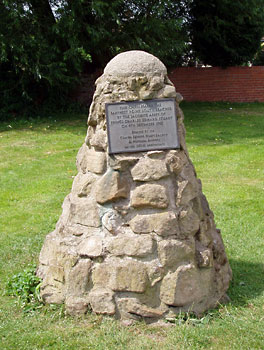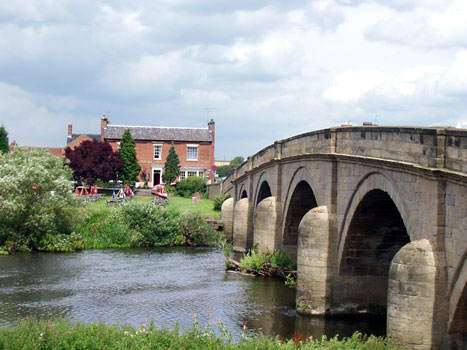 |
 |
 |
| Commemorative Cairn | The Crewe and Harpur Arms viewed from across the Trent |
 |
 |
 |
| Commemorative Cairn | The Crewe and Harpur Arms viewed from across the Trent |
Serendipity is the art of making pleasing findings by chance and so it was with this monument in Swarkestone. While travelling from Cheshire to see the Saxon carvings at Breedon on the Hill we stopped for lunch at the Crewe and Harpur Arms in Swarkestone. As it was a fine day, we ate in the beer garden and found the monument shown in the photograph. The inscription reads:
Erected by the
Charles Edward Stuart Society
& Marston's Brewery
on the 250th anniversary
Charles Stuart landed at Malaig in mid 1745. From August to October, he gathered supporters but not all the clans who had been for his father in 1715 were for the cause in 1745. He had a victory at Preston Pans in September but then wasted time which George II used to gather troops. British soldiers in Flanders were brought back as well as Dutch and Hanoverian mercenaries. All Scotland except Stirling was in Jacobite hands.
In November and December 1745 the county militias melted away. There was a legal problem in raising the militias without having the money to pay them. The Pretender advanced and it was said that George II had his bags packed ready to leave. There was financial panic in London. The speed of the Jacobite successes in the north caught the Hanoverians by surprise. The Scottish armies raised revenue on their march from excise duties and other normal public revenue but even so were short of money. Charles regarded the Highland army as unstable and unreliable. He thought it would break up if there was a loss of momentum. At the same time he believed that some military success was needed if the French were to be persuaded to invade to support him. However, the French were too late with invasion plans and treasure ships were sunk so that money for the Jacobites did not arrive. In addition he thought that some success in England would be required to stimulate the English Jacobites to join him.
The Jacobite plan had three flaws. Firstly there was poor communication with the French. They had not made effective contact with their English supporters and had no accurate intelligence on enemy movements. They has spectacular success until Derby and the rate of advance surprised the Hanoverians. The Duke of Cumberland barred the way to London but the Jacobites made a feint towards Congleton as if heading for Newcastle-under-Lyme or Wales. Cumberland moved west but the Jacobite contingent in Congleton moved to Leek to join the other troops marching there from Macclesfield. The Jacobites moved from Leek to Ashbourne and on to Derby. For a time the road to London was open and Cumberland had to move quickly to plug the gap.
On 8 December 1745, Lord George Murray, the Pretender's commander and the clan leaders lost their nerve, believing themselves and their lines of communication too exposed. They were mislead about the strength of the Hanoverian forces by the double-agent, Dudley Bradstreet. There was no news from the French and no significant support from English Jacobites. Charles could not give proof that they would rise. Nine miles south of Derby, at Swarkestone, they turned and managed to elude General Wade.
From January to April 1746 there was a naval blockade of Scotland to stop French aid. By the time of the Battle of Culloden the army was paid in provisions only and many were half starved. The assumption of command by Charles himself proved disastrous. Charles had no money and the French treasure fleet was lost. It was a tactical blunder to offer battle at Culloden as the terrain of open heath was unsuitable for the ambush style of attack in valleys which was favoured by the Scots. Charles had 5000 troops to the 8000 of Cumberland and the Jacobite army was destroyed in half an hour. The highlanders charged Cumberland's cannon. Charles eventually escaped to France after five months. Cumberland launched a reign of terror. Some Jacobites fled to become mercenaries in France.
In 1746/7 the clan system was dissolved and the plaid banned. General Wade built Fort George and a road system to allow armies to move more quickly. Leading Jacobites like Lords Lovatt and Kilmarnock were executed. About 120 others died in prison, a further 100 were executed and others banished or transported to North America.
As a medical footnote it is interesting that "Bonnie Prince Charlie", the "Popish Pretender", and George II, the Protestant King, died of the consequences of syphilis, a condition suffered also by the Pretender's grandfather, James II and his great uncle, Charles II.
Sources:
The Invasion of 1745: the Drama in Lancashire and Cheshire,
by Peter J. C. Smith, published by Neil Richardson, 1993, ISBN 1 85216 076 4
Riot, Rebellion and Revolution in 18th century Staffordshire, six lectures by Rose Wheat at Wedgwood Memorial College, Winter 2001/2
The Death of Kings: A Medical History of the Kings and Queens of England,
by Clifford Brewer, Abson Books, London, 2000, ISBN 0 902920 99 5